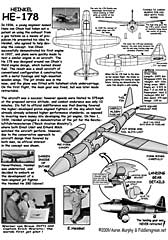


Heinkel-178 - $$5.95
The Heinkel He 178 was the world's first aircraft to fly under turbojet power, and the first practical jet plane. It beat the Whittle powered Gloster E28 by about a year and a half. The He-178 was just a testbed and flew only a couple times. The Gloster E28 model is also in the Fiddlersgreen Collection (see above) Display stands included
Heinkel He-178-Worlds First Turbo Jet-1939
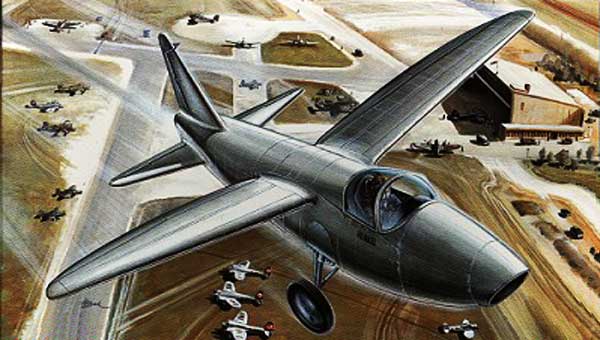
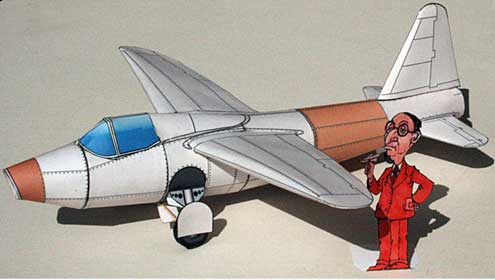
Purely experimental, the He-178 was the worlds first turbojet-powered aircraft, flying nearly two years before the British Gloster E28.
The Heinkel He-178 was a small and fairly basic aircraft.
What made it exceptional was that it was powered by a gas turbine, or jet engine. Work on this type of propulsion was in hand in other countries, but Germany had reached the starting line first. Now, at 06.00 on Sunday, August 27,1939, Flugkapitan Erich Warsitz opened the throttle and sent the strange looking propellerless machine trundling down the runway at Marienehe. Gradually it gained speed, and after a rather long run, lifted into the air.
The landing gear was locked down, and no attempt was made to explore the flight envelope. It was enough to prove the new propulsion system. Warsitz turned back towards the airfield, but mist was rolling in, and he had to fly several circuits before it was clear enough to land. This first flight by jet propulsion lasted 15 minutes.
This is the Heinkel He-178 model that won the FG Modeling Madness (FGMM) 2010 best in class prize. Thanks to Péricles Lopes Gomide Filho for his entry !! |
|
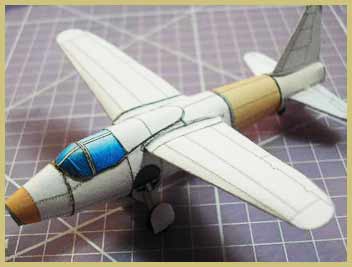 |
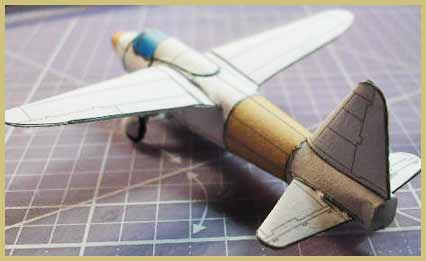 |
An interesting tidbit I ran across was that the landing gear WASN'T retractable, although it looks like it should be. Supposedly they were going to make it retractable later, but never got around to it. Aaron (Fiddlersgreen designer) Evidently, it jambed and since it was just a test bed, they hadn't any real need to fix it
RE; the first Italian jet.
Actually, you could say it was the Stipa-Caproni and be done with it, or it could be the Caproni Thermo-Jet that used the same principles with an internal combustion engine driving the compressor and additional fuel injected into the compressed, heated air stream. It is worth mentioning the distinctions among these early jets in that the Whittle engines had centrifugal compressors and were not turbo jets. Turbo jets have a turbine in the exhaust that drives an axial compressor up front. Centrifugal compressor engines are characterized by large air intakes up front, making the fuselages seem inordinately fat. Hence, the Gloster, Yak, and the Mig-15 had centrifugal compressors; whereas the German jets used axial flow compressors as did most American jets beginning at least with the Lockheed P-80. Then, as you know from your original aero background, there are engines that use aerodynamic compression (ram jets) and mechanically assisted compression (pulse jets). The key is that combustion requires a certain residence time in the combustion chamber for the reaction to release chemically stored energy. The airstream has to be compressed, but it is as important that the airstream be slowed down so that combustion occurs inside the combustion chamber rather than downstream in the nozzle or even outside of the engine. Dave Finkleman
A nice model, but let's not let misinformation spread around. A turbojet consists of a compressor, combustor, turbine, and a nozzle. It doesn't matter whether the compressor is axial or "centrifugal" - it's still a turbojet.
Also, the P-80 used the same English Whittle engine used in the Gloster E28, so it had a centrifugal compressor. The engine was built in England and shipped to Lockheed. Despite the fact that the engine had a centrifugal compressor, the Lockheed P-80 had side inlets. A Modeling Pal
I want to thank you for your quick response on the He-178 and willingness to go the extra mile. I've never seen that level of customer service anywhere. It's clear this is a labor of love for you.
I very much appreciate it. Robert (Mike) Melendez
Heinkel He-178
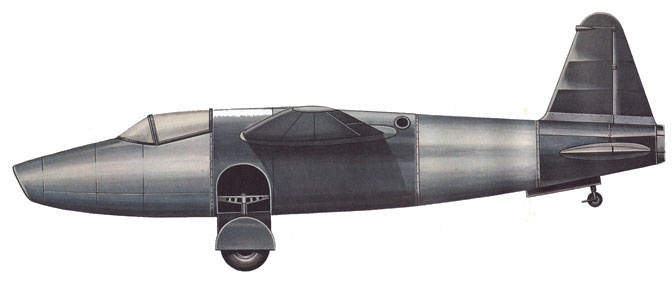
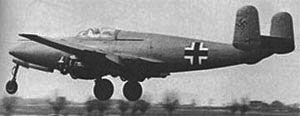 The first turbojet engines were barely more powerful than the larger piston engines of the time, but as manufacturing and operating experience was improved their power quickly increased. One of the major challenges was to develop metals that could withstand the heat and stress generated within the engines. Before long, the aerodynamic problems of high speed flight beyond the Mach 1, the so called sound barrier would also present themselves to scientists and designers
The first turbojet engines were barely more powerful than the larger piston engines of the time, but as manufacturing and operating experience was improved their power quickly increased. One of the major challenges was to develop metals that could withstand the heat and stress generated within the engines. Before long, the aerodynamic problems of high speed flight beyond the Mach 1, the so called sound barrier would also present themselves to scientists and designers
The Heinkel He-178 was powered by the company's HeS 3b gasoline burning engine with an effective rating of just 1,100 pounds of thrust. The He-178 became the worlds first turbojet powered airplane to fly when on that August day in 1939 , Flugkapitan Erich Warsitz made a flight around the factory airfield at Rostock-Marienehe, Germany.
Development was pretty much a private venture and it was not until October 28, 1938 official observers namely, Milch, Udet and Lucht of the Reichsluftfahrtministerium were to see the aircraft in flight.. The project attracted little interest and work was discontinued in favor of the He-280 (right)
The great moment for Heinkel, von Ohain, and for Erich Warsitz came in the early morning hours of August 24, 1939. The He-178 took of under its own power, made a straight flight, turned and landed. There was only one fault: the landing gear jammed,. forcing Warsitz to remain under the planned speed. A new milestone had been laid, and in great excitement Heinkel, at 4:30 that morning, telephoned his friend Ernst Udet in Berlin. "It was some time before Udet, drowsy and cross, answered," Heinkel said in his autobiography, "A Stormy Life." "'Good morning, Heinkel here. I just wanted to report that Flight Captain Warsitz has successfully flown the world's first jet plane, the He 178, with the world's first jet engine, the He S 3-8, and landed safely after the flight. " There was silence at thc other end of the line. Then Udet growled back: 'Well then, fine. I congratulate you. And Warsitz too. But now let me get some sleep !"'
Germany's top officials slept all too well during this period. It was not until the report slipped out of England through devious channels that Great Britain was about to test her first jet aircraft- the Gloster Whittle E 28/39-that it dawned on them what scientists and designers had long believed: a revolution in aviation was at hand. No narrow-mindedness on the part of the government curbed the aircraft industry's search for progress either in England or in the United States. Even Italy got into the act independent of German developments.
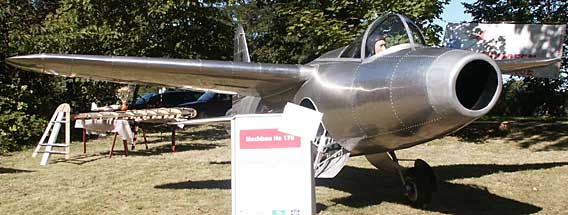
This (above) seems to be a very well made reproduction of the Heinkel He-178
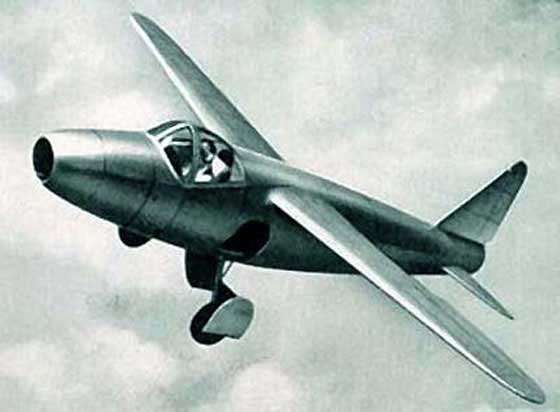
The interesting role of the Heinkel He-118:
The He-118 before testing with the Heinkel He S 3a turbojet engine 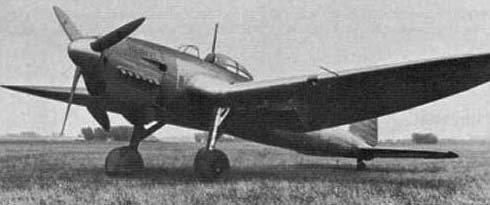 |
The He-118 had resulted from a design competition for a single engine dive bomber and had been also rejected by the Technical O{lice in Berlin. It appeared to be ideally suited for the new project. The internally-braced, mid-wing monoplane had an all-metal stressed skin, and oval cross-cut fuselage. Its main advantage was the relatively high (retractable) landing gear, which allowed an He S 3-B engine to be mounted under the fuselage. Flight Captain Kunzel, who was working with Warsitz on the testing program, started up the turbine at an altitude 1,350 ft,; the machine surged forward with a noticeable jolt and disappeared from view.
The landing was also made by propeller; nevertheless, the He-118 had flown with a jet engine. All of the test flights were successful-except for one. The pilot had a narrow escape when the engine suddenly caught fire and burned up after the plane had already taxied to a standstill. Luckily he managed to leap out of the cabin in time to save himself.
Designed in 1935 with it's first flight on January 14, 1936, the He-118 was competitor to the Ju-87 for the Luftwaffe's new dive bomber, the He-118 proved to be a more that capable aircraft, but in the end Junkers was awarded the contract. Altogether 13 aircraft were made with two being sold to Japan.

The He 118 made it's mark in history however by being the first aircraft to fly with a turbojet engine powering it- the He S 3a- if only briefly!:
It was in the summer of 1938, when testing of the new engine moved from the test bed to finding out how it would perform under flying conditions. The engine was mounted beneath the fuselage and between the wings of the He 118 as it had a high ground clearance which allowed for the safe fitting and maintenance of the engine. Test flights would start at around 4am and end at 6am this was to keep the development secret, the He-118 would take off under the power of it's piston engine, later igniting the He S 3a, which would result in a loud noise and a blue flame from the jet engine and a notable turn of speed from the He-118. In the buildup to the flight of the He-178, the He-118 was flown on turbojet power alone, it's piston engine being cut off briefly in flight. At the time there were reports in near by villages of strange sounds, and in one case bits of metal dropping out of the sky!!.
The Japanese had been so impressed with the He-118 that they had bought from Germany that they planned to produce it in a modified form for carrier operation, but during a test flight the test plane had broken up in midair. So late in 1938 the Yokosuka Arsenal, was instructed to design a replacement inspired by the He-118. Chief Engineer Masao Yamana and his team created a clean mid-wing monoplane not only smaller and lighter than its inspiration, the He-118, but it had an internal bomb-bay and a longer range. Called the Yokosuka D4Y Suisei (Judy) total production of all variants came to 2,038 by the end of the war.
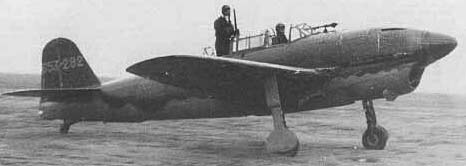
Later when asked what it felt like, I said, "It felt as if angels were pushing'..... General Leutnant Adolf Galland |
|
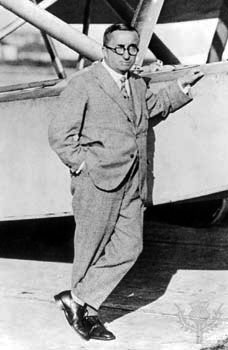 The He-178 was a private venture by the German Heinkel company in accordance with director Ernst Heinkel's emphasis on developing technology for high-speed flight |
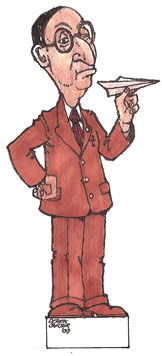 |
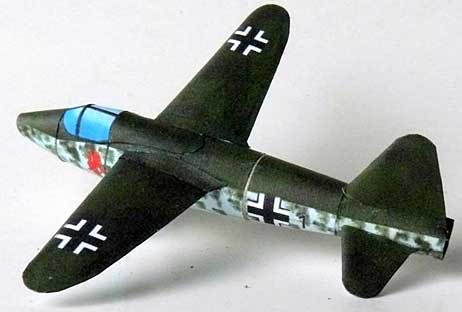 |
Guido Van Roy sends this He-178 with fantasy markings which is quite different from the actual He-178. "Attached are the 4 sheets for a fantasy Luftwaffe version of the Heinkel He.178. As the use of swastika symbols is very much contested in Germany I decided not to add these" Guido |
|
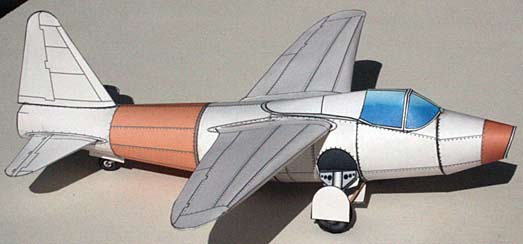 |
Modeln' Pal Bob Penikas was first to send in these photos of the Heinkel He-178 and the comments below.. |
Other than the horizontal stab design previously sent no real problems, just me: Wing: my first wing assembly was not competition worthy due to me re-gluing the wing trying to get a correct dihedral; printed another wing and constructed a wing spar. Canopy: I had to add a small white square gap fill to the front canopy windshield where it attaches to the nose. Just my build I guess, I fussed with trying to get a nice fit all around but gave up. Guessing the landing gear: I guessed at placing the longer side of the Landing Gear Bracket on top and the landing gear strut with the longer end opening attached to the wheel. I selected flat tooth picks sanded round for more believable size struts and attached the bottom join of two to the base of the Landing Gear Strut. I guess the landing gear door that glues directly to the wheel on the real He-178 is attached to the axlehousing; at least that is how I’ll explain it to the rivet counters. Main Wheels: were stuffed with pieces of kleenex tissue. Tail Wheel: Inserted cardboard to thicken the tire and attached to fuselage with a thin wire. Landing Gear Details illustration. The gear door attaching to the wheel is not the shape provided on the parts page. No biggie with the actual He-178 photo below the detail. That's all I remember for this experience...Thank you for the model, Bob |
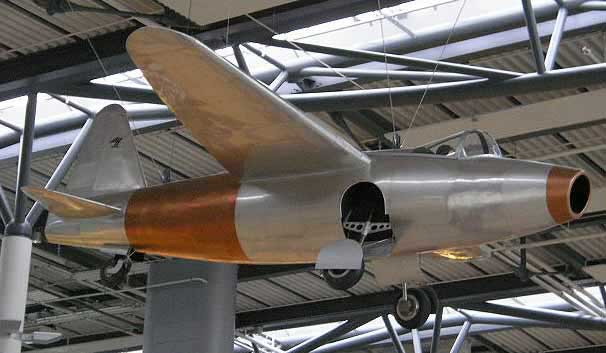 This is He-178 reproduction hanging in a museum |
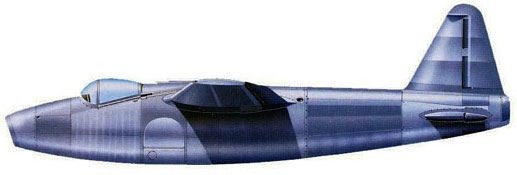 A drawing of the He-178, curiously, with its landing gear retracted. |
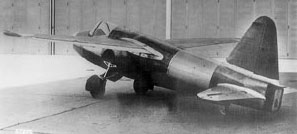 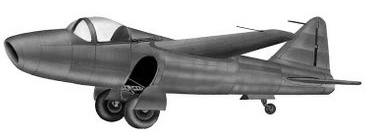 Two more images of the Heinkel He-178 |
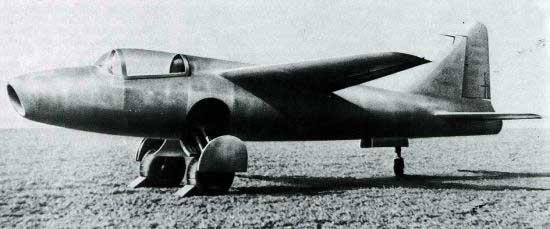 An old photo of the Heinkel He-178 worlds first jet aircraft. |
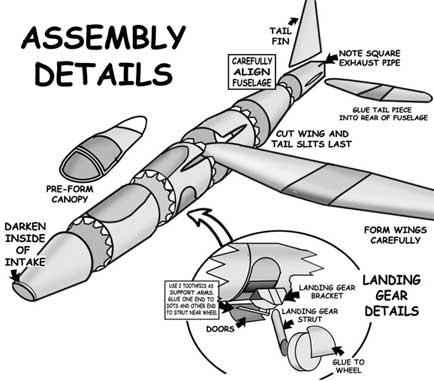
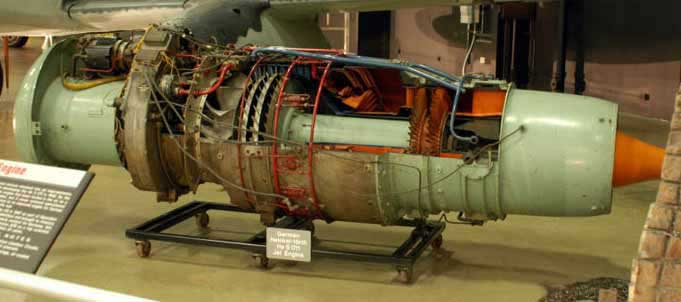 |
Ohain Jet Turbine engine. |
Specifications
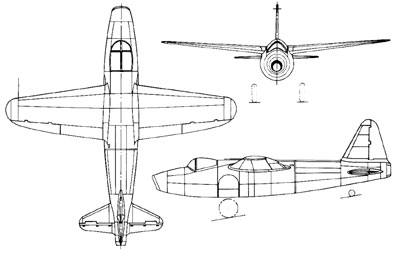 |
Length: 24 ft 6 in Wingspan: 23 ft 3 in Height: 6 ft 10 in Wing area: 98 ft² Empty weight: 3,572 lb Max takeoff weight: 4,405 lb Powerplant: 1× HeS 3 turbojet, 992 lbf Performance Maximum speed: 380 mph Range: 125 mi |
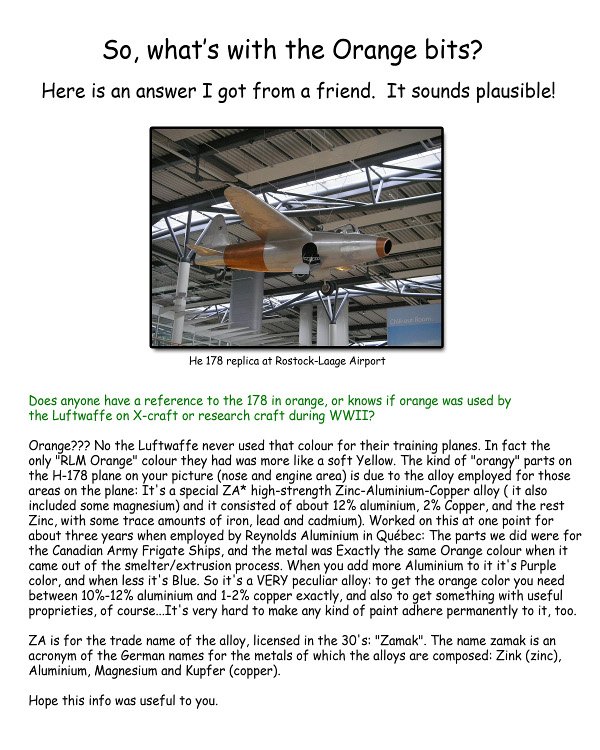 |



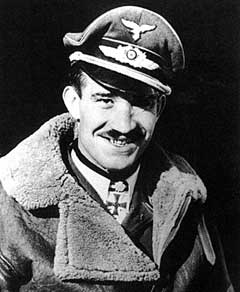 'For the first time I was flying by jet propulsion. No engine vibrations. No torque and no lashing sound of the propeller. Accompanied by a whirling sound, my jet shot through the air.
'For the first time I was flying by jet propulsion. No engine vibrations. No torque and no lashing sound of the propeller. Accompanied by a whirling sound, my jet shot through the air. 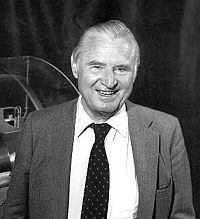
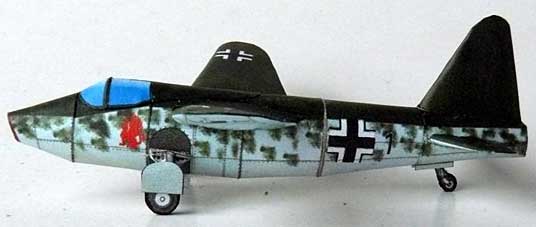
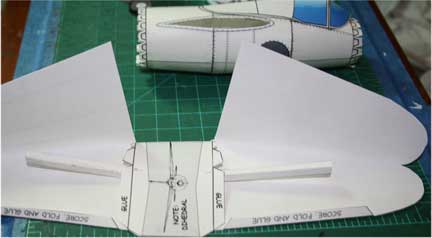 The photo shows the spar before I tapered the outboard edges.
The photo shows the spar before I tapered the outboard edges.